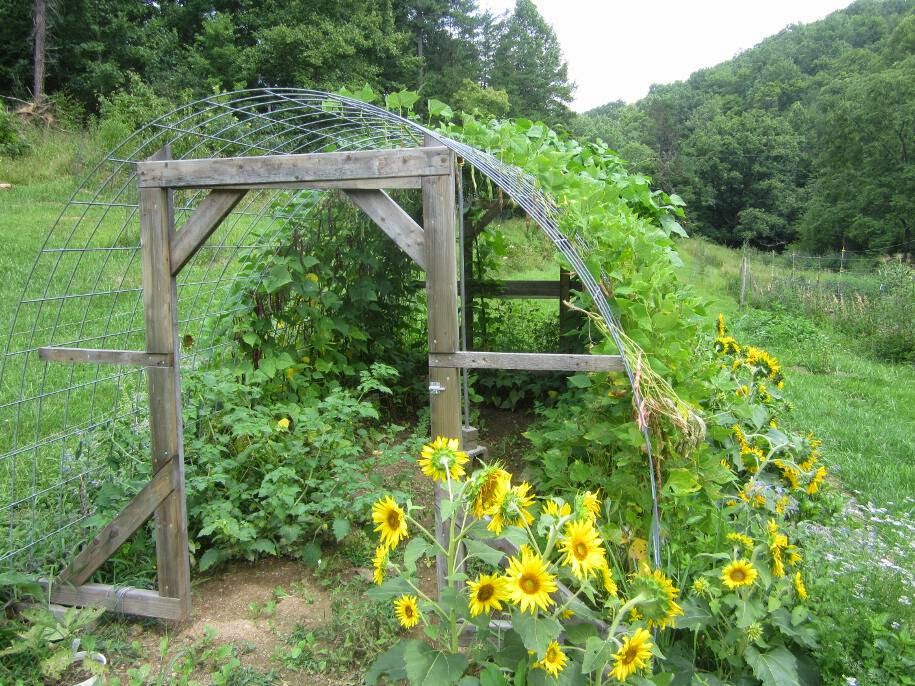It's been awhile since I wrote a post about a typical day here at the Wolfe house. Our day begins with opening the chicken coop and closely watching the hens scatter into the weeds to lay their eggs. With the snake coming and going from the coop, only two hens lay eggs in the coop. Finding the nests in the weeds have been a challenge because the hens only lay in the same spot for a few days before they make a new nest. The nest in the picture was located next to the creek where a very large snapping turtle lives so I promptly moved the eggs. We would love to have baby chicks (in case they get broody), but the snapping turtle is a bit of a threat.
The snake left for about a week but promptly returned to devour two eggs before I gathered them.
Most days we throw something outside the garden fence or patio door for the chickens to eat. In the picture above they are devouring a squash that was half rotten. We did cull one of the barred rocks a few weeks ago. She was the runt of the litter who was bullied by the other hens and she even started pulling out her own feathers. When she stayed in the coop all day and lost a lot of weight, I decided it was time to cull her. For weeks there were eggs in the nest box without shells and ones that easily broke when touched. It was no surprise that when she was culled, she was egg bound. Her grooming habits had lessened and she also had a terrible case of lice. I promptly treated the flock with
Poultry Protector even though they all looked really good thanks to daily dust baths.

Fresh produce decorate the kitchen counters all summer long. This year we have a beautiful assortment of tomatoes. The yellow ones are Wapsipinicon peach. With the temperatures being somewhat cool this summer, we have been enjoying fresh bread as well! Using the oven and keeping windows open all day long is a treat!
The garden is a jungle right now with so many weeds, sprawling tomatilloes, and never-ending squash vines. I'm not sure how or when this happened, but the tomatoes took over! In the picture above there is no room to walk and you can barely see two distinct rows. This crowding is a bit of a concern for spreading of disease and picking the tomatoes without damaging the plants.
Many of the tomato plants have some blight but these black tomatoes are looking terrific! The stalks and leaves are healthy and the tomatoes don't show signs of rot. We aren't sure what the actual name of these tomatoes are because we saved the seeds from a tomato our friend Anna, so we affectionately call them "Anna's Black" tomatoes.
And of course, it's not summer in our home without the small room next to the kitchen cluttered with preserving supplies...canning jars, food dehydrator, canning pot, cider press, etc. It is nice having this extra space so I don't have to put things away after each use.

This summer the honeybees have been left alone to do their own thing. Each hive started with not even 10 frames of partial comb so harvesting honey was wishful thinking. During our recent inspection, one hive was very prolific with four frames of solid capped honey whereas the other had not a single frame of solid honey. Both hives look healthy with a good population and laying queen. Entrance reducers were put on both hives because last August, the hives were robbed by the yellow jackets and wax moths. The entrance reducers should help the colonies defend their home and reduce any robbing that may occur between the two hives. In the picture above you can see Paul wearing very little while my friend and I are performing an inspection. He is not afraid of the bees and is always present during inspections. The last incident of a honeybee sting happened when he was 2.5 years old in a small pool. Three years later he is still running around barefoot through clover wearing only a pair of underwear all summer long. Paul is a pretty care-free child who runs across gravel barefoot and rolls in the weeds filled with chiggers.

Every year we use a different trellis for beans but we are never satisfied with the results. The beans always seem to run out of room, trellises fall over, or the beans are too crowded. This year Jon came up with a brilliant idea to use the
greenhouse as a bean trellis! There isn't much use for the greenhouse during the summer because of our hot and humid temperatures so we removed the plastic covering and planted things in and around the greenhouse frame. I will be blogging about the bean trellis soon but everyday we stop by to marvel at the number of hanging beans and to observe the pollinators on the sunflowers.

And after a day of hunting for eggs, preserving produce, pulling weeds, and making plans for the next day, we take some time to walk around the garden and mini orchard to enjoy the fruits of our labor. It is so easy to get caught up with all the work that needs to be done, but we stop and do what we call a "walk around." This is a time for meandering around to observe everything and pat ourselves on the back. While Paul runs ahead of us to marvel at how much his asian pear tree has grown; Jon is squeezing a peach to check for ripeness; and I watch honeybees make their final trip home for the day covered in bright orange pollen.



































